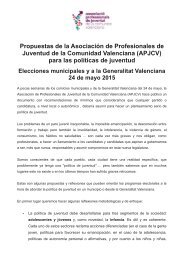c39dc
c39dc
c39dc
Create successful ePaper yourself
Turn your PDF publications into a flip-book with our unique Google optimized e-Paper software.
and civic competences, sense of initiative and entrepreneurship and<br />
cultural awareness and expression. Several of these key<br />
competences relate to ‘soft-skills’ aspects. A number of them, such<br />
as social and civic competences, sense of initiative and<br />
entrepreneurship and cultural awareness and expression could be<br />
closely associated with the kind of activities that youth organisations<br />
aid in developing.<br />
Often, however, the terms “skills” and “competences” are used<br />
interchangeably, for instance in the OECD skills strategy 33 , which<br />
defines skills (or competences) as the bundle of knowledge, skills<br />
and capacities that can be learned and that enable individuals to<br />
successfully and consistently perform an activity or task and can be<br />
built upon and extended through learning. Such strategy refers to<br />
‘soft skills such as teamwork, communication and negotiation’ but<br />
also ‘sense of command, initiative and honesty 34 ’. There is,<br />
therefore, some agreement on the ‘substance’ of soft skills, even<br />
when there are different approaches to their definition or the use of<br />
the term skills, competences or personality traits. There is also<br />
agreement that these skills are important for economic<br />
development and innovation 35 . Given its simplicity for stakeholders<br />
and the purposes of this report we adopt the OECD approach,<br />
using the terms skills and competences broadly interchangeably.<br />
2.3 Employability, qualifications and skills<br />
This section reviews recent trends on the relationship between<br />
employability, qualifications, and skills. Employability is understood<br />
here as the relative chance of finding and maintaining different kinds<br />
of employment 36 . Employability depends on fulfilling the requirements<br />
of a specific job and also on how one stands relative to others within<br />
a hierarchy of job seekers. Employability, thus, has two dimensions:<br />
its external conditions (the labour market) as well as individual<br />
characteristics (individual dimension). Brown and Hesketh (2004 37 )<br />
refer to these as “relative employability” (related to the variable<br />
conditions of the labour market), and “absolute employability” (related<br />
to individual attributes such as skills and knowledge), both of which<br />
affect the degree to which an individual can gain employment. Even<br />
in very different labour markets, skills and competences enhance<br />
employability at the individual level, therefore the absolute dimension<br />
33 OECD (2012) Better skills, better jobs, better lives. A strategic approach to skills policies. OECD, Paris, p.12. See<br />
also Toner, P. (2011) Workforce skills and innovation. An overview of major themes in the literature. OECD<br />
Education Working Papers, number 55. OECD, Paris.<br />
34 OECD (2012) Better skills, better jobs, better lives. A strategic approach to skills policies. OECD, Paris.<br />
35 Toner, P. (2011) Workforce skills and innovation. An overview of major themes in the literature. OECD Education<br />
Working Papers, number 55. OECD, Paris.<br />
36 Brown, P., Hesketh, A. and Williams, S. (2002) ‘Employability in a knowledge driven economy’ Working Paper<br />
Series number 26, University of Cardiff.<br />
37 Brown, P. and Hesketh, A. (2004) Employability and Jobs in the Knowledge Economy. Oxford, Oxford University<br />
Press.<br />
19




